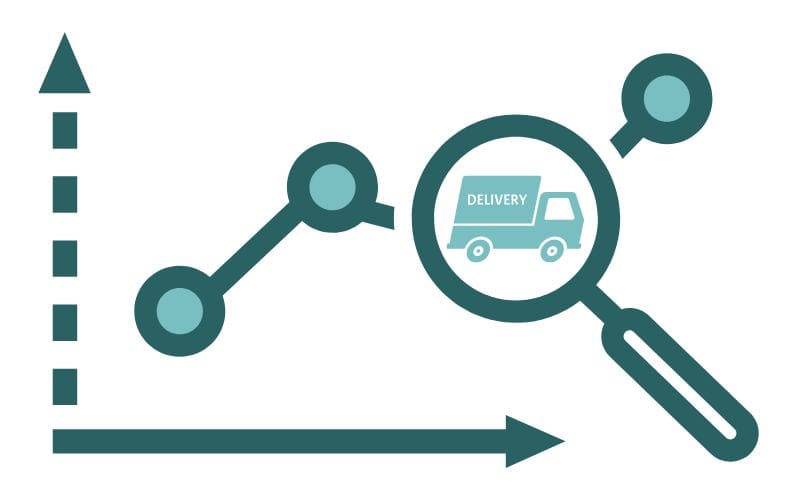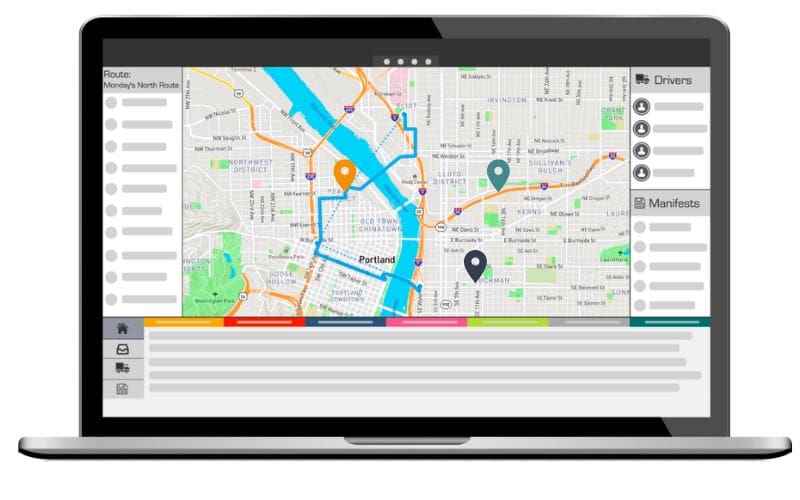
From communication and connectivity to healthcare and transportation, the importance of big data can’t be overstated and the role of driver dispatch is crucial. Fleet managers constantly strive to fine-tune operational efficiency, reduce costs, and provide better customer service. One big ally in all their efforts: data.
Gone are the days when driver dispatch relied solely on gut instincts and guesswork. Today, fleet managers are embracing big data to make smarter decisions and optimize their operations. With advanced technologies like GPS tracking, telematics, and fuel monitoring, fleet managers now have access to a wealth of real-time data that provides unparalleled visibility into their fleet’s activities. This data allows them to monitor vehicle performance, track driver behavior, and gain insights into fuel use patterns. By making use of this valuable information, fleet managers can boost their driver dispatch strategies, greatly reduce delays, and take their entire operation to the next level.
Data in driver dispatch goes beyond real-time visibility—it empowers fleet managers to predict maintenance needs, identify trends, and make proactive decisions. By analyzing historical data, fleet managers can forecast when a vehicle may need maintenance, permitting them to schedule routine service and minimize downtime. Data analysis also allows them to see patterns and trends in driver behavior, route optimization, and fuel usage. Armed with these predictive insights, fleet managers can adjust schedules, assign drivers more effectively, and refine dispatch routes for optimal performance and reduced expenses.
The Role of Data in Driver Dispatching
Data serves as a guiding compass in driver dispatching, allowing fleet managers to gain valuable insights into driver performance, and better routes while proactively addressing potential challenges.

At the heart of driver dispatching lies the importance of data. By using real-time and historical data, fleet managers can make the best use of their resources, assign drivers to tasks based on their skills and availability, and dynamically adjust routes to ensure timely deliveries. Data provides a comprehensive understanding of driver behavior, allowing fleet managers to identify areas for improvement. provide targeted training, and improve the driver’s overall performance. With powerful data guiding the decision-making process, fleet managers can transform their entire operation and gain an edge over the competition.
When it comes to driver dispatching, several types of data can be highly useful. Real-time data provides instant visibility into the location and status of vehicles. GPS tracking and telematics technologies allow fleet managers to monitor driver routes, identify areas of traffic congestion, and reroute drivers accordingly. This real-time data empowers fleet managers to make agile decisions, reducing delays and fine-tuning driver assignments. Historical data is equally significant, offering insights into driver patterns, performance trends, and areas for improvement. Historical data helps fleet managers pinpoint bottlenecks, streamline operations, and establish best practices for driver dispatching.
Up-to-the-minute weather data plays a vital role in driver dispatching too. Unpredictable weather conditions can really hurt driver schedules and overall efficiency. By integrating weather data into the dispatching process, fleet managers can anticipate potential disruptions, adjust routes proactively, and ensure the safety of their drivers. With a proactive, data-driven approach, fleet managers not only reduce delays but can also make more on-time deliveries to meet customer needs, even in challenging weather conditions.
Harnessing Real-Time Data for Dynamic Dispatching
The ability to make real-time decisions on the fly is vital for driver dispatching. By leveraging real-time data, fleet managers have the information they need to make good decisions at any point in time.
One of the key benefits of real-time data in driver dispatching is having instant visibility into the location and status of fleet vehicles. Fleet managers can dynamically assign drivers to tasks based on proximity, availability, and skillset. Real-time data empowers fleet managers to respond swiftly to unexpected events like traffic congestion or last-minute customer requests. With this level of agility at your command, you can reduce delays, boost productivity, and overcome any unexpected obstacles.

GPS tracking and telematics technologies provide real-time visibility for driver dispatching. GPS tracking enables fleet managers to monitor vehicles’ exact locations, track routes, and detect any deviations or inefficiencies, often in time to make adjustments. Telematics systems provide additional data points like vehicle speed, fuel usage, and driver behavior. When you integrate these technologies into the dispatching process, fleet managers can fine-tune route planning and proactively address any issues that may arise.
Successful implementation of real-time data in driver dispatching has already shown impressive potential in several industries. For example, if a logistics company implemented a real-time tracking system that provided instant updates on driver locations, vehicle conditions, and delivery statuses they could use the information to optimize its dispatching process, reduce idle time, and greatly improve on-time performance. A ride-hailing service could use real-time data to match drivers with passengers based on proximity, resulting in shorter wait times and happier customers.
Predictive Analytics & Route Optimization
The ability to optimize routes and assignments is a real game-changer. By using historical data and advanced machine learning models, fleet managers can make data-driven decisions that result in efficient driver dispatching.
Predictive dispatching uses historical data and sophisticated machine-learning models to anticipate future patterns and trends. By analyzing vast amounts of data, including driver performance, traffic patterns, weather conditions, and delivery schedules, fleet managers can make accurate predictions regarding optimal driver assignments. This allows for proactive decision-making and the ability to assign the right driver to the right task at the right time. Predictive analytics allows fleet managers to stay ahead of the game.
Optimizing routes and assignments with data-driven insights is another crucial aspect of driver dispatching. By analyzing historical data and real-time information, fleet managers can pinpoint the most efficient routes taking into consideration factors like traffic congestion, road conditions, and delivery priorities. Advanced algorithms can calculate the best routes, factoring in several variables all at once, resulting in reduced travel time, better fuel usage, and increased productivity.
Successful implementation of predictive analytics and route optimization in driver dispatching has shown remarkable promise and results. For example, a delivery company might integrate predictive analytics into its dispatching process, using historical data to forecast demand and assign drivers accordingly. The proactive approach would help them reduce delivery time, improve customer satisfaction, and make the best use of the company’s resources. Another transportation company might implement route optimization algorithms. As a result, they will reduce their mileage, lower fuel costs, and see a jump in driver productivity.
Enhancing Safety and Compliance Through Data Analysis in Driver Dispatch
Ensuring driver safety and compliance is one of the most important aspects of driver dispatching. Fortunately, data analysis and telematics provide valuable tools to help meet these goals. Fleet managers can monitor driver behavior, and adherence to regulations while identifying potential risk factors to improve safety and compliance in their operations.
Data analysis and telematics offer a way for fleet managers to ensure driver safety and compliance. With the right data from telematics devices, onboard sensors, and driver logs, fleet managers can gain comprehensive visibility into each driver’s behavior and performance. It can help identify potential safety risks like speeding, harsh braking, or erratic driving patterns. By proactively monitoring and analyzing this information, fleet managers can provide targeted training programs to address unsafe behaviors. The data can also help them build a culture of safety and compliance within their driver fleet.
Fleet managers can use the data to ensure regulatory compliance in driver dispatching. By closely monitoring driver hours of service, required rest periods, and compliance with transportation regulations, fleet managers can address risks and problems associated with non-compliance before they are real problems. Fleet managers have all the information they need to identify potential violations and help take corrective actions promptly, reducing the likelihood of penalties, fines, and reputational damage. Compliance-focused data analysis provides a proactive approach to ensure that driver dispatching operations align with industry regulations and best practices.
A transportation company, for example, could implement telematics systems to monitor driver behavior and analyze data related to speed, acceleration, and harsh braking. By providing drivers with real-time feedback and targeted coaching, the company could successfully reduce unsafe driving incidents and improved overall safety performance. A logistics provider could use data analysis to identify non-compliant driver hours of service and implement automated alerts and reminders, resulting in improved regulatory compliance and reduced risks.

Data Integration and Management for Smarter Dispatching
Data integration and centralized management form the foundation of a well-optimized driver dispatching system. By integrating data from various sources like GPS trackers, telematics devices, customer orders, and driver logs, dispatchers gain comprehensive visibility into the entire operation. A centralized database ensures that all relevant data is readily accessible, eliminating silos and enabling a holistic view of the dispatching process. This integrated approach allows dispatchers to work smarter, determine better routes, and use resources effectively.
Purpose-built dispatching software streamlines the entire process by automating data collection, organizing information, and providing real-time statistics. These software solutions often integrate well with other systems and devices, facilitating efficient data exchange and reducing manual errors. With dispatching software, dispatchers can track driver locations, monitor performance metrics, and capture valuable data points for analysis. The technology helps dispatchers save time, improve accuracy, and enhance overall dispatching efficiency.
To ensure successful data integration and smarter dispatching, it’s important to follow best practices.
- First, establish clear data collection protocols and standardize data formats across all systems and devices. Consistent data entry practices reduce the number of inconsistencies and enable seamless integration.
- Regular audits clean the data to remove duplicate entries, errors, and outdated information. This ensures that the integrated data remains accurate and reliable for decision-making purposes.
- Invest in robust security measures to protect sensitive data. Driver dispatching involves handling confidential information, including driver details, customer information, and route data. Implement encryption, user authentication.
- Regular data backups safeguard against unauthorized access and data loss.
Prioritizing data security instills trust in your dispatching operations and protects the privacy of all stakeholders involved.
Summary
The power of data integration, real-time insights, predictive analytics, and enhanced safety measures help organizations unlock significant benefits in driver dispatch operations. The integration of real-time data has revolutionized driver dispatching. By effectively using GPS tracking and telematics, organizations gain valuable visibility into their fleet operations. They can monitor driver locations, optimize routes in real-time, and make smart dispatch decisions. This data-driven approach not only improves overall efficiency but also improves safety and greatly enhances customer satisfaction.
Predictive analytics and route optimization are powerful tools in driver dispatching. By using historical data and machine learning models, organizations can predict maintenance needs, optimize routes, and make data-driven assignments. Data analysis and telematics contribute significantly to safety and compliance in driver dispatching. By monitoring driver behavior, adherence to regulations, and identifying risk factors, organizations can take proactive measures to enhance safety and ensure compliance. Dispatching software plays a crucial role in enhancing data collection, organization, and accessibility. By following best practices for data integration, organizations can ensure seamless integration of data from various sources, maintain data accuracy, and protect sensitive information.
Conclusion
With Elite EXTRA’s Routing and Dispatch software, businesses can access and use driver data to optimize routes for efficient deliveries, streamline operations through full operational visibility, and retain happier customers with faster order fulfillment and real-time updates. The software seamlessly integrates with many popular business systems and streamlines the route planning process by considering factors like efficiency, time windows, and customer priority.
Dispatching routes and orders to drivers is made easy, whether they are within your fleet or part of Elite EXTRA’s Delivery Network. Updating customers with email and text notifications, along with order tracking and updates, is a great way to improve your customers’ overall experience. The EXTRA Driver mobile app guides drivers throughout the entire fulfillment process, ensuring smooth operations from route dispatch to proof of delivery. Elite EXTRA’s fully integrated last-mile ecosystem offers featured integrations that further enhance logistics operations.
To learn more about how Elite EXTRA can streamline last-mile logistics and maximize the benefits of data-driven dispatching, request a demo today and we’ll show you how Elite EXTRA can meet all your logistics needs.
Sources
https://ops.fhwa.dot.gov/publications/
https://www.forbes.com/
https://www.worktruckonline.com/







